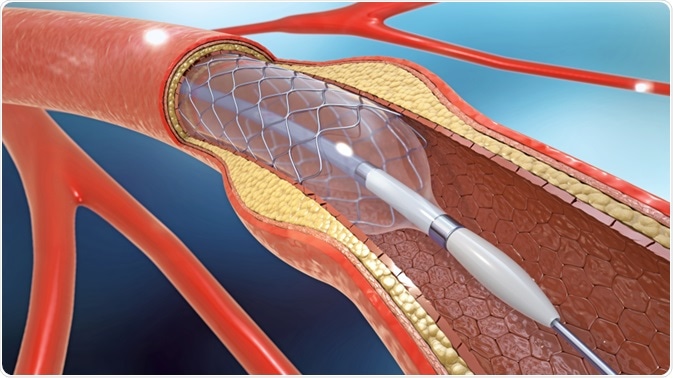Stents are expandable tubes that are used to treat patients with damaged or narrowed arteries. Since the 1970s, the optimum management of coronary heart disease has been a major focal point of research and development.
Stenting in coronary artery disease
Coronary artery disease is caused by plaque building up in the coronary arteries, which narrows and weakens these vessels. Usually made of metal mesh, coronary stents are often placed inside a narrowed artery in a procedure referred to as percutaneous coronary intervention (PCI) or angioplasty. Implantation of a stent helps ensure the vessel is kept open, improves blood flow to the heart muscles, and decreases the likelihood of another blockage occurring.
Unlike other procedures such as coronary artery bypass surgery (CABS), PCI is considered minimally invasive because it does not require any major incisions. The patient is mildly sedated and given a local anesthetic. Typically, the PCI procedure usually takes around one hour, although it can take longer if several steps are required. Patients who have a stent implanted experience less pain and recover more quickly as compared to patients who undergo CABG.

Image Credit: Christoph Burgstedt / Shutterstock.com
Originally, stents were made of bare metal material. Although these devices prevented the artery from collapsing, they only modestly decreased the risk of the artery re-narrowing, which is otherwise known as restenosis. In fact, around 25% of people treated with a bare-metal stent for coronary artery disease experienced restenosis within just six months.
Researchers therefore started developing stents that were coated with agents that would prevent restenosis. These drug-eluting stents (DES), which eventually became approved by the United States Food and Drug Administration (FDA), have shown that they significantly reduce the rate of restenosis in many clinical trials.
However, it should be noted that DES are not completely risk-free, as blood can form a clot inside the stent many years after it has been implanted. Referred to as “in-stent thrombosis,” this condition can be fatal it is essential that patients who have a stent implanted during PCI take anti-clotting agents such as Effient, Plavix or Ticlid after the procedure.
Alternatives to PCI and DES
Laser angioplasty
The laser angioplasty procedure is similar to angioplasty; however, in this procedure, the catheter has a laser tip that is used to open up the artery. Pulses of light beams then vaporize the build-up of plaque.
Atherectomy
The atherectomy procedure is also similar to angioplasty; however, in this procedure, the catheter includes a shaver at its tip which rotates to cut away plaque.
CABG
A CABG is the most commonly performed but most invasive procedure available for treating patients with an obstructed coronary artery. The procedure involves bypassing the blocked part of the artery by attaching a segment of a blood vessel, or graft, that has been obtained from another part of the body to the coronary artery, either on the blocked or narrowed side of the artery. This can permanently restore blood flow by redirecting the blood around the blockage and through the newly placed graft.
CABG is an open-heart surgery and therefore requires the surgeon to make a large incision in the middle or side of the chest to expose the heart. This procedure can take up to six hours and patients need to stay in the hospital for at least three days to recover once the CABG has been completed. Patient recovery time is around 4 to 6 weeks and most people can return to work within one or two months of the surgery.
Cardiomyoplasty
A cardiomyoplasty is an experimental procedure that involves the use of skeletal muscles that have been taken from the abdomen or back. These muscles are then wrapped around the heart to provide extra muscle that is stimulated by a device to boost the organ’s pumping motion.
Heart transplant
In a heart transplant, the diseased and irreversibly damaged heart is removed and replaced with a donated healthy heart.
Port-access coronary artery bypass
A port-access coronary artery bypass procedure is an alternative to CABG and requires only small incisions or “ports” to be made in the chest. Through these ports, instruments are passed to perform the bypass.
The heart is stopped during the procedure and an oxygenator or “heart-lung” machine is used to pump blood. Arteries from the chest or veins from the leg are used to bypass the obstructed artery.
References
Further Reading
Last Updated: Jan 18, 2023